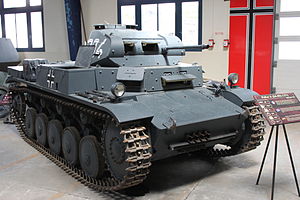| Panzerkampfwagen II Sd.Kfz. 121 | |
|---|---|
 PzKpfw II Ausf. C at the Musée des Blindés | |
| Type | Light tank |
| Place of origin | Nazi Germany |
| Service history | |
| In service | 1936–1945 |
| Wars | World War II |
| Production history | |
| Designed | 1934–1936 |
| Unit cost | 52,640 ℛ︁ℳ︁ (Ausf. B) |
| Produced | 1935 – January 1944 |
| No. built | 1,856 (excluding conversions) |
| Specifications (Ausf. c-C) | |
| Mass | 8.9 t (8.8 long tons) |
| Length | 4.81 m (15 ft 9 in) |
| Width | 2.22 m (7 ft 3 in) |
| Height | 1.99 m (6 ft 6 in) |
| Crew | 3 (commander/gunner, driver, loader) |
| Armor | 5–15 mm (0.20–0.59 in)[1] |
Main armament | 1 × 2 cm KwK 30 L/55 Ausf. a–F 1 × 2 cm KwK 38 L/55 Ausf. J–L |
Secondary armament | 1 × 7.92 mm Maschinengewehr 34 |
| Engine | Maybach HL62 TRM 6-cylinder petrol 140 PS (138 hp, 103 kW) |
| Power/weight | 15.7 PS (11.6 kW) / tonne |
| Suspension | Leaf spring |
| Ground clearance | 0.35 m (1 ft 2 in)[1] |
| Fuel capacity | 170 L (45 US gal)[1] |
Operational range | Road: 190 km (120 mi)[1] Cross country: 126 km (78 mi)[1] |
| Maximum speed | 39.5 km/h (24.5 mph)[1] |
The Panzer II is the common name used for a family of German tanks used in World War II.[2] The official German designation was Panzerkampfwagen II (abbreviated Pz.Kpfw. II).[2]
Although the vehicle had originally been designed as a stopgap while larger, more advanced tanks were developed, it nonetheless went on to play an important role in the early years of World War II, during the Polish and French campaigns.[2] The Panzer II was the most numerous tank in the German Panzer divisions at the beginning of the war.[3] It was used both in North Africa against the Western Allies and on the Eastern Front against the Soviet Union.
The Panzer II was supplanted by the Panzer III and IV medium tanks by 1940/1941.[4] By the end of 1942, it had been largely removed from front line service and it was used for training and on secondary fronts.[4] The turrets of the then-obsolete Panzer Is and Panzer IIs were reused as gun turrets on specially built defensive bunkers,[5] particularly on the Atlantic Wall. Production of the tank itself ceased by January 1944, but its chassis remained in use as the basis of several other armoured vehicles, chiefly self-propelled artillery and tank destroyers such as the Wespe and Marder II respectively.[4]
- ^ a b c d e f Jentz 1996, p. 278.
- ^ a b c Suciu, Peter (2021-03-08). "Why Nazi Germany Relied So Much on the Panzer II Tank". The National Interest. Retrieved 2021-12-30.
- ^ Niehorster, Leo. "Dr". WWII Orders of Battle and Organizations. Retrieved 4 August 2018.
- ^ a b c "SdKfz 121 Panzer II". www.militaryfactory.com. Retrieved 2021-12-30.
- ^ Stannius, Mark. "Tank turrets". The Atlantic Wall in Denmark. Mark Stannius. Retrieved 28 December 2014.